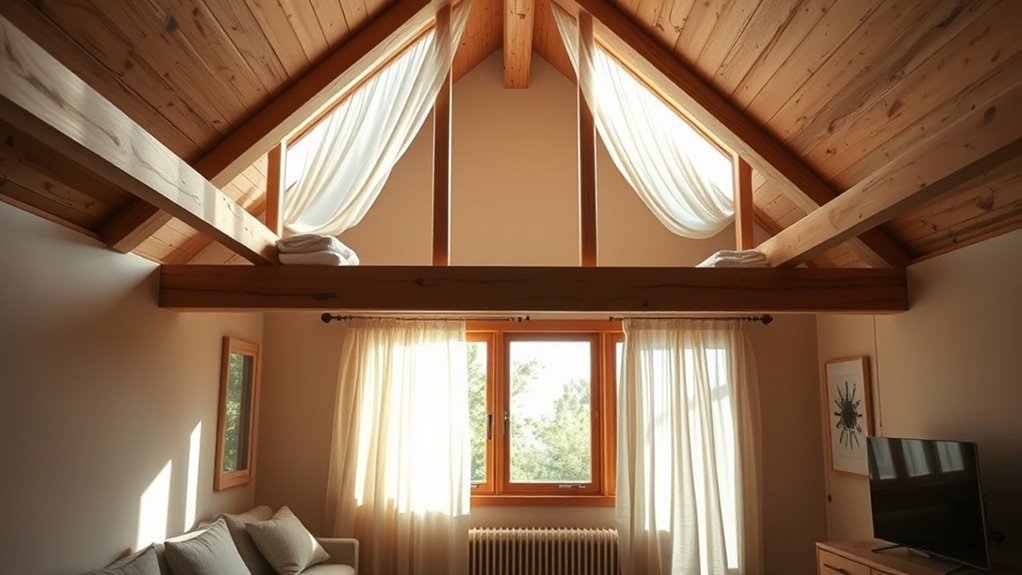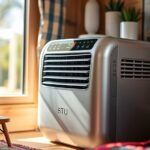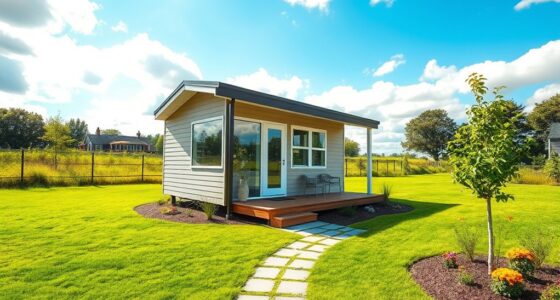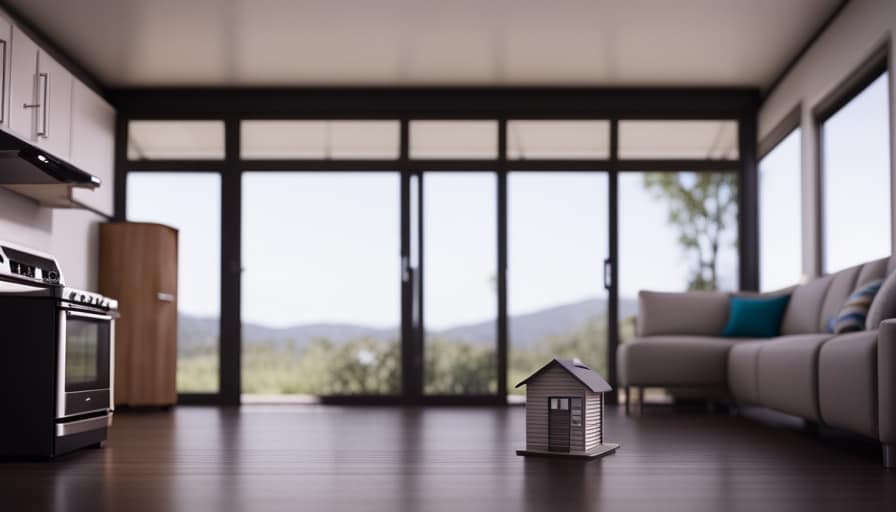To create healthy, comfortable tiny-house lofts, prioritize natural airflow through strategic window placement on opposite or adjacent walls aligned with prevailing winds, and include roof vents or skylights for hot air escape. Use operable windows and passive techniques like vents and louvers to boost ventilation, and consider mechanical systems like exhaust fans or HRVs for improved air quality. Managing moisture and integrating building biology principles guarantees a healthy environment—exploring these details further will help you design smarter, more breathable spaces.
Key Takeaways
- Proper window and vent placement, aligned with prevailing winds, promotes natural airflow and enhances indoor air quality in tiny house lofts.
- Mechanical systems like exhaust fans and HRVs help mitigate stagnant air and moisture buildup in confined loft spaces.
- Building biology principles emphasize non-toxic, breathable materials and strategic airflow to reduce pollutants and support occupant health.
- Addressing loft-specific airflow challenges involves using roof vents, fans, and thoughtful furniture placement to maintain healthy microclimates.
- Incorporating passive airflow techniques and innovative solutions ensures efficient ventilation, improving comfort and durability in tiny house lofts.
The Importance of Cross Ventilation in Tiny-House Lofts
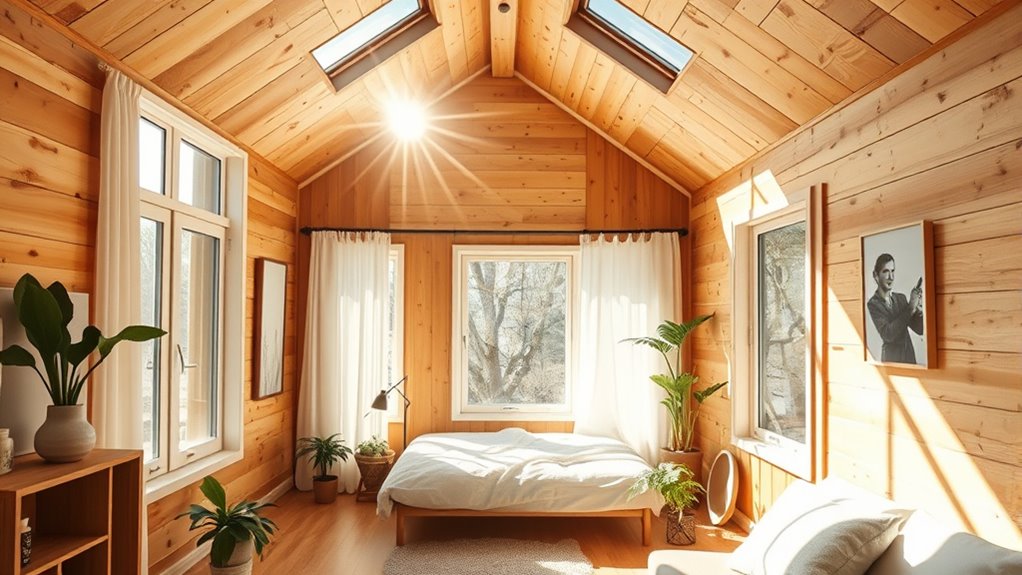
Why is cross ventilation so essential in tiny-house lofts? It’s fundamental because it guarantees fresh air circulates freely, preventing stale air buildup. Proper window placement on opposite walls creates a natural airflow path that pulls in cool air and pushes out warm, moist air. Skylights and clerestory windows enhance this process by allowing warm air to escape through the roof, improving overall airflow. Installing operable windows gives you control over ventilation, letting you adjust airflow as needed. Furniture arrangement also plays a role—placing pieces to avoid obstructing air pathways keeps the airflow smooth. Structural support is vital too; the loft must handle occupants and furniture without blocking vents or compromising ventilation. Effective cross ventilation improves air quality, reduces humidity, and maintains a comfortable, healthy environment. Creating effective airflow pathways is crucial for maintaining indoor air quality and overall comfort in tiny-home lofts. Additionally, incorporating building biology principles can help optimize the indoor environment by focusing on healthy airflow and material choices.
Natural Strategies for Enhancing Airflow in Small Spaces
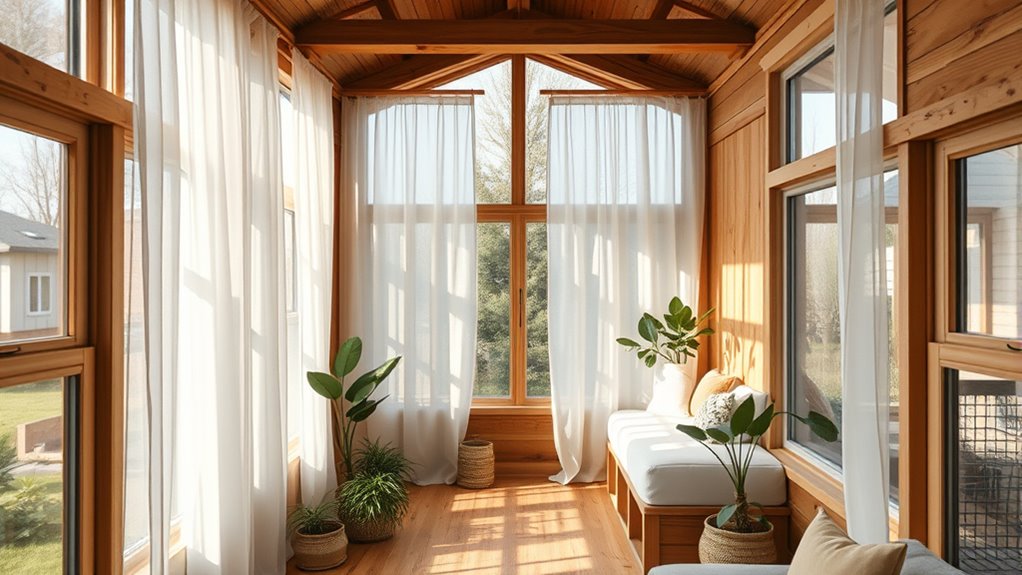
To enhance airflow in your tiny house, you should focus on optimizing cross ventilation with strategic window and vent placement. Passive techniques like using louvered vents and perforated materials help move air naturally, reducing the need for fans. Combining these methods with thoughtful orientation ensures fresh air flows efficiently through your small space. Promoting air exchange without drafts through strategic airflow management is essential to maintain comfort and air quality in limited spaces. Additionally, understanding how contrast ratio affects visibility can help you choose window coverings that optimize natural light while controlling glare.
Cross Ventilation Optimization
Optimizing cross ventilation in tiny houses involves strategic placement of openings and thoughtful design choices to maximize airflow naturally. Start by positioning windows and vents on opposite sides of your space, ideally facing prevailing winds, to create a direct airflow path. Keep the distance between openings short, as this enhances the efficiency of airflow. Incorporate operable windows and consider adding skylights or roof vents to facilitate warm air escape and draw in cooler air. Place windows on windward and leeward sides to harness breezes effectively. Arranging furniture to avoid blocking air pathways and designing rooms with minimal depth also boost ventilation. These strategies work together to improve indoor air quality, regulate temperature, and reduce reliance on mechanical systems.
Passive Airflow Techniques
Passive airflow techniques harness natural forces to improve ventilation in small spaces like tiny-house lofts without relying on mechanical systems. These methods use environmental factors and smart design to promote air movement, enhancing indoor air quality and comfort. Utilizing natural wind and buoyancy can significantly reduce the need for electric fans or air conditioning, making them especially suitable for tiny homes aiming for sustainability. Passive Stack Ventilation uses warm air rising and cooler air sinking through vertical openings like skylights or vents, creating a natural flow. Venturi Effect employs narrow passages to accelerate airflow, helping to draw air through limited spaces and regulate temperature. Windcatchers capture prevailing winds to funnel fresh air inside, even with minimal openings. Single-Sided Ventilation places vents or windows on one side to generate airflow using wind pressure differences. Clerestory and Roof Vents**** high-level vents release hot air, promoting upward airflow and passive cooling. Incorporating passive airflow strategies enhances energy efficiency and supports sustainable living in tiny homes.
Selecting and Positioning Operable Windows and Skylights
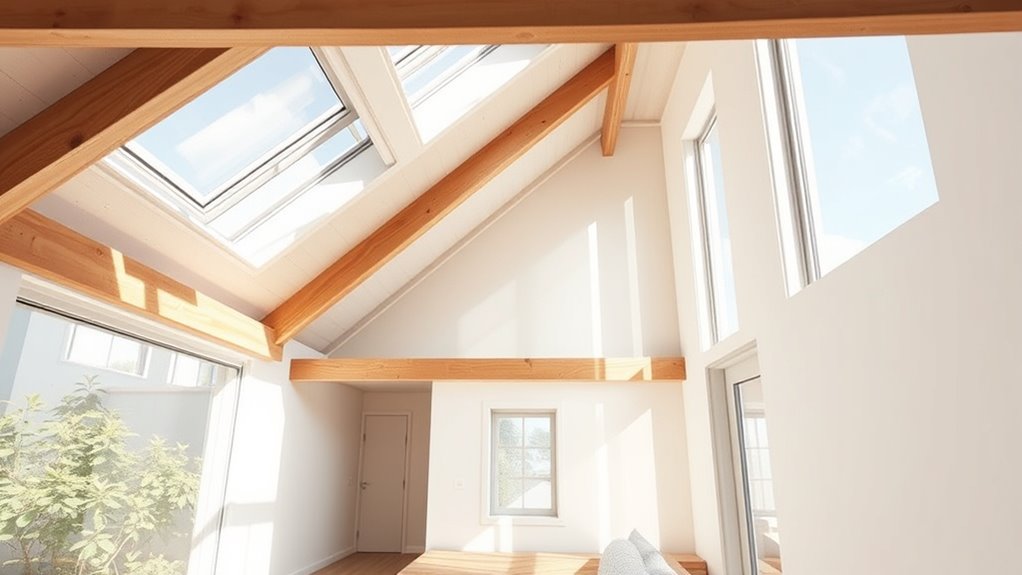
Selecting and positioning operable windows and skylights in a tiny house loft requires careful planning to maximize airflow, natural light, and occupant comfort. Choose window types like casement or awning windows that open fully or hinge at the top for better ventilation and weatherproofing. Sliding windows save space and are easy to operate, while double-hungs offer flexible control from top and bottom. Position windows on opposite or adjacent walls to promote cross-ventilation, and align them with prevailing winds for ideal breeze capture. Incorporate skylights or roof vents to allow warm air to escape naturally. Proper placement and selection of window types enhance comfort, air quality, and energy efficiency in your tiny house loft. Choosing energy-efficient windows can further reduce heating and cooling costs. Additionally, considering cost-effective window options and proper placement can help stay within your budget while improving airflow and lighting. Ensure furniture and storage don’t block airflow, and consider high ceilings to improve air circulation.
Mechanical Ventilation Systems and Indoor Air Quality Management
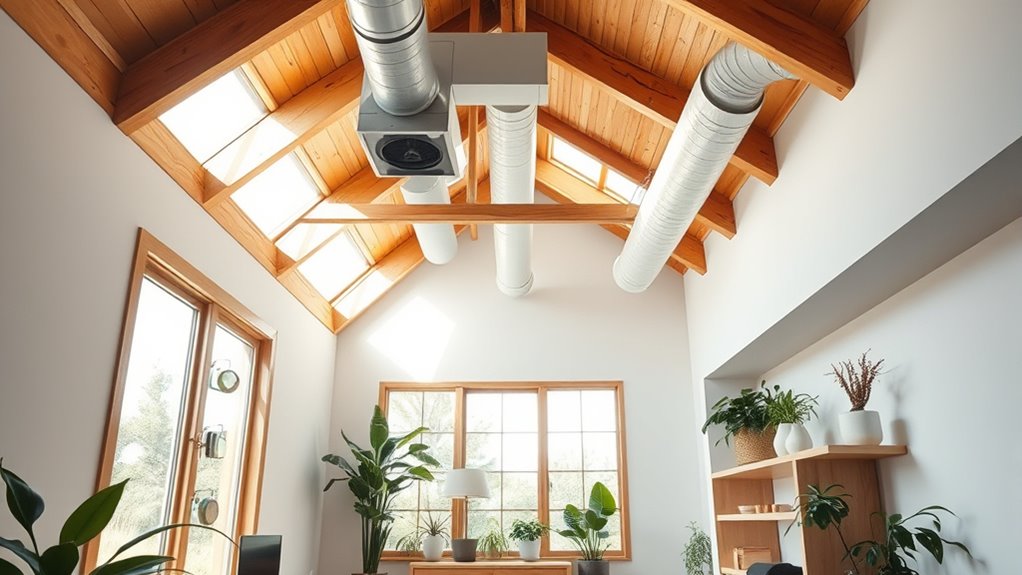
Mechanical ventilation systems play a essential role in maintaining good indoor air quality in tiny houses, especially where space limits natural airflow options. They help remove stale air, odors, and excess humidity, ensuring a healthier environment. Common systems include exhaust fans, HRVs, and ERVs, which should be selected for energy efficiency, such as Energy Star rated fans. Proper placement is critical—especially in moisture-prone areas like kitchens, bathrooms, and lofts—to prevent stagnation and humidity buildup. Regular maintenance, including cleaning and checking for blockages, keeps the systems performing at their best. Here’s what you should consider:
Mechanical ventilation ensures air quality by removing humidity, odors, and stale air in tiny homes through efficient, well-placed systems.
- Strategic placement near moisture sources
- Selecting energy-efficient fans
- Balancing airflow for cross-ventilation
- Installing in loft areas for moisture control
- Routine cleaning and maintenance
Preventing Moisture Accumulation and Mold Growth in Loft Areas
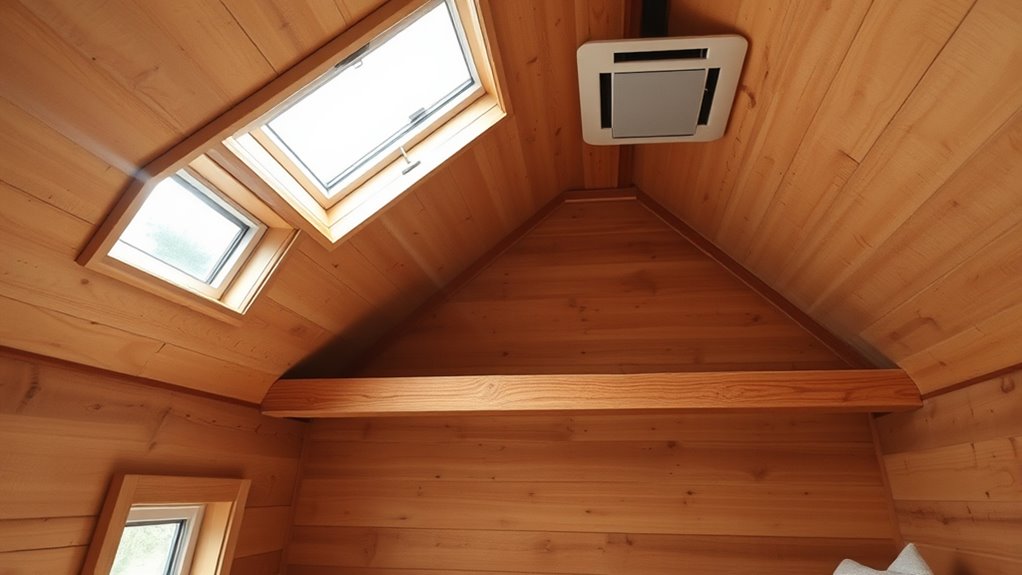
To prevent moisture buildup and mold growth in loft areas, it’s essential to implement effective ventilation, proper vapor barrier placement, and diligent sealing. Install vapor barriers on the warm side of insulation to block moisture from reaching wall cavities, avoiding trapping moisture on both sides. Guarantee vents and fans are strategically placed to promote airflow, especially in hotspots like bathrooms and kitchens. Use hygrometers and dehumidifiers to monitor and control humidity levels. Seal cracks around windows, doors, and electrical openings to prevent moist air infiltration. Proper airflow beneath loft mattresses and stored items helps prevent trapped moisture. Proper ventilation not only reduces excess moisture but also helps to maintain a healthy indoor environment. Incorporating airflow management techniques such as adjustable vents and strategically placed exhaust fans can further optimize moisture control. Here’s a quick overview:
| Strategy | Focus Area | Result |
|---|---|---|
| Ventilation & Fans | Airflow in lofts | Reduces stagnant moisture |
| Vapor Barrier Placement | Wall cavities | Stops condensation |
| Sealing Structural Gaps | Air leaks | Prevents moisture infiltration |
| Humidity Monitoring | Indoor air quality | Maintains ideal moisture |
| Moisture-Resistant Materials | Loft construction | Reduces absorption and mold |
Designing for Energy Efficiency and Climate Adaptability

Designing tiny house lofts for energy efficiency and climate adaptability involves thoughtful consideration of insulation, ventilation, and material choices. Proper insulation helps regulate indoor temperatures despite limited space, while smart ventilation prevents moisture buildup and enhances airflow. Using sustainable, climate-resilient materials supports durability and environmental harmony. Incorporating energy-efficient systems like solar panels, propane, and smart thermostats reduces energy consumption and costs. The portable nature of tiny houses allows you to relocate for better climates, and seasonal adjustments to insulation and ventilation optimize comfort year-round. To deepen your understanding, consider these key points:
Optimize tiny house lofts with smart insulation, ventilation, and renewable energy for adaptable, energy-efficient living.
- Climate-specific insulation strategies
- Ventilation integration for airflow and moisture control
- Solar and renewable energy options
- Material choices for durability and efficiency
- Seasonal and regional adaptation techniques
- Understanding merchant services and their integration can help optimize energy management and security features in tiny homes.
Loft-Specific Airflow Challenges and Innovative Solutions
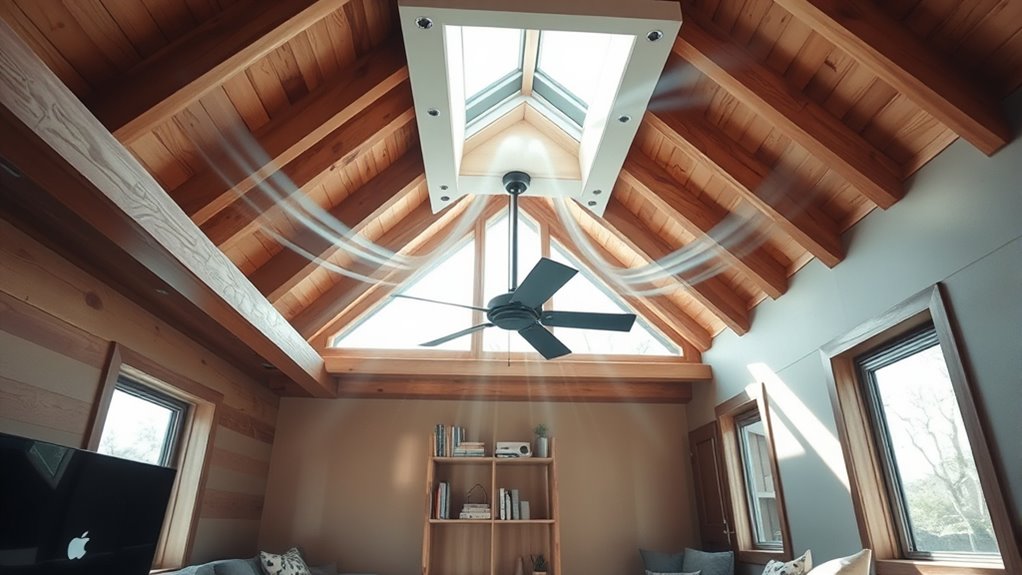
Lofts in tiny houses often trap stagnant air, making it hard for fresh air to reach and circulate properly. Limited natural ventilation options worsen this problem, creating uncomfortable microclimates and humidity issues. Innovative solutions like small fans, roof vents, and mechanical systems can help improve airflow and maintain healthier conditions. Additionally, considering building biology principles can ensure that airflow solutions promote healthier indoor environments and reduce potential health risks.
Stagnant Air in Lofts
Stagnant air is a common challenge in loft spaces, especially in tiny houses where limited room and structural constraints hinder proper ventilation. Without good airflow, you risk moisture buildup, mold growth, and poor indoor air quality. Hot and cold spots can develop, making the space uncomfortable. Traditional ventilation options are often hard to install due to space restrictions, so air tends to stay trapped. To combat this, consider solutions like ceiling fans, roof vents, or compact systems such as LUNOS e2. These help improve airflow and reduce moisture. Proper design choices, like strategic furniture placement and cross-ventilation, also make a difference. Incorporating AI-powered smart devices can further optimize ventilation by monitoring air quality and adjusting airflow in real-time. Addressing stagnant air not only boosts comfort but also protects your health by minimizing mold and pollutants.
Limited Natural Ventilation
Limited natural ventilation presents unique airflow challenges in loft spaces, primarily because of their structural constraints. Loft walls often have less window area, reducing natural airflow pathways. Proper ventilation is essential to maintain air quality and prevent health issues in loft environments. Layout can block or restrict airflow due to low ceilings and partition walls. Humidity tends to build up because of limited ventilation options, increasing mold risk. To improve airflow, consider positioning windows on opposite walls for cross-flow, using operable or skylight windows, and consulting professionals for ideal solutions. Without adequate natural ventilation, lofts can quickly become humid, stale, and unsafe. Small loft volumes and sealed construction can lead to oxygen depletion if not properly vented. Incorporating airflow considerations into design can significantly enhance comfort and safety in loft spaces.
Innovative Airflow Solutions
Addressing airflow challenges in tiny house lofts requires innovative solutions that go beyond traditional ventilation methods. Loft spaces often suffer from poor air circulation, high humidity, and heat buildup due to limited openings and design constraints. To improve airflow, you can incorporate various clever strategies.
- Use through-the-wall fans with airflow adapters to actively circulate air between the loft and main areas
- Install compact, rechargeable fans with multiple speeds for flexible airflow support
- Integrate heat/energy recovery ventilators (HRVs/ERVs) for balanced fresh air and temperature retention
- Add exhaust fans in kitchens or bathrooms to reduce humidity and improve overall air quality
- Utilize vented loft floors or grilles for better exchange between the loft and lower levels
These innovations help combat stagnant air, moisture buildup, and temperature stratification efficiently.
Implementing a comprehensive ventilation strategy can further enhance indoor air quality and energy efficiency in tiny house lofts.
Integrating Building Biology Principles for Healthy Air Circulation
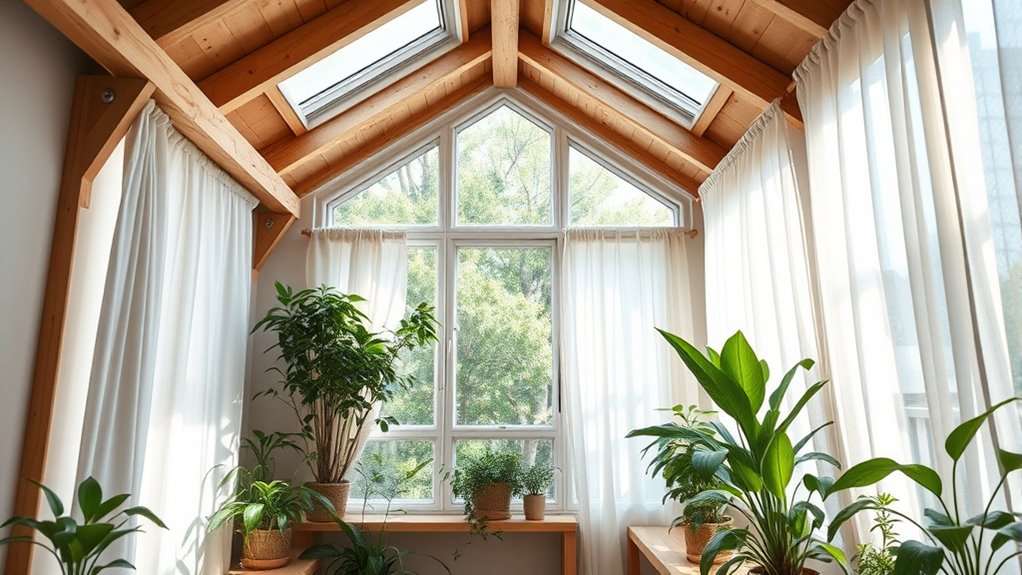
Integrating building biology principles into tiny-house loft designs guarantees healthier air circulation by emphasizing natural materials, strategic ventilation, and moisture control. Choosing hygroscopic materials like clay, lime, and straw helps regulate indoor humidity, preventing mold and reducing airborne toxins. Earth-based wall systems allow vapor and air to flow naturally, avoiding condensation issues. Proper window placement and operable skylights optimize cross-ventilation and utilize prevailing winds, flushing out stale air. Combining natural airflow with mechanical systems like heat recovery ventilators ensures continuous fresh air without energy loss. Moisture management is key—using vapor-permeable walls and avoiding synthetic barriers prevents condensation buildup. Monitoring humidity and airflow patterns safeguards against mold growth, creating a healthier environment. Building biology principles foster a balanced, self-regulating airflow that enhances indoor air quality in tiny-house lofts, and incorporating natural ventilation strategies can further improve airflow effectiveness.
Frequently Asked Questions
How Can I Improve Airflow Without Sacrificing Privacy or Security?
To improve airflow without sacrificing privacy or security, you can use passive strategies like roof vents, trickle vents, and soffit vents that promote fresh air exchange discreetly. Mechanical systems like HRVs and ERVs efficiently circulate air while maintaining privacy. Additionally, interior design choices such as open layouts, screen dividers, and strategic furniture placement help optimize airflow without opening windows or compromising safety.
What Are the Best Ventilation Options for Extremely Cold or Humid Climates?
In the battle between comfort and the elements, you need the armor of smart ventilation. In cold or humid climates, you should opt for Heat Recovery Ventilators (HRVs) or Energy Recovery Ventilators (ERVs). HRVs are great for cold, while ERVs balance humidity in humid environments. Pair these with exhaust fans and natural strategies like roof vents or trickle vents to maintain airflow, prevent moisture buildup, and keep your tiny house healthy.
How Do Passive and Mechanical Ventilation Systems Work Together Effectively?
You can make passive and mechanical ventilation work together by combining natural airflow paths with controlled mechanical systems. Use passive vents and well-placed windows to promote natural convection, while installing energy-efficient HRVs or ERVs to recover heat and guarantee consistent fresh air exchange. This hybrid approach maximizes airflow, minimizes energy use, and maintains indoor air quality, especially in tight or small spaces where efficient ventilation is essential.
What Maintenance Is Required to Keep Ventilation Systems Mold-Free?
Ever imagine your ventilation system as a gust of fresh air? To keep it mold-free, you should clean vents and exhaust fans regularly, inspect ductwork for leaks or moisture, and promptly remove any mold you find. Change filters every 3 to 6 months, ideally using HEPA filters. Use exhaust fans in moisture-prone areas and keep vents unobstructed. Schedule annual professional inspections to guarantee everything stays efficient and mold-free.
How Can I Prevent Drafts While Maximizing Natural Airflow in My Tiny House Loft?
To prevent drafts while maximizing natural airflow, you should start by installing operable windows with adjustable vents, like casement or sliding types. Use trickle vents for controlled air exchange, and position openings low and high to create a gentle chimney effect. Incorporate ceiling fans to circulate air without creating drafts, and avoid blocking vents with furniture. Combining natural openings with balanced ventilation systems keeps air fresh without uncomfortable drafts.
Conclusion
By prioritizing cross ventilation and thoughtful design, you can turn your tiny-house loft into a gust of fresh air—a sanctuary that breathes with you. Embrace natural airflow strategies and building biology principles to prevent moisture build-up and guarantee healthy indoor air quality. When you optimize your space’s airflow, you’re not just avoiding mold and discomfort—you’re creating a living environment that feels as open and invigorating as a gentle breeze on a warm day.
I’m Theodore, and I love tiny houses. In fact, I’m the author of Tiny House 43, a book about tiny houses that are also tree houses. I think they’re magical places where imaginations can run wild and adventures are just waiting to happen.
While tree houses are often associated with childhood, they can be the perfect adult retreat. They offer a cozy space to relax and unwind, surrounded by nature. And since they’re typically built on stilts or raised platforms, they offer stunning views that traditional homes simply can’t match.
If you’re looking for a unique and romantic getaway, a tree house tiny house might just be the perfect option.
